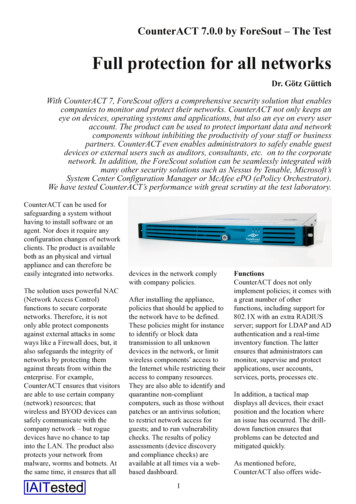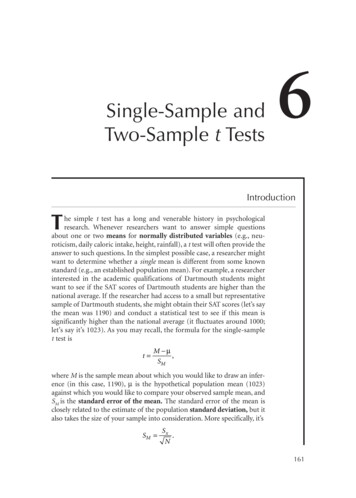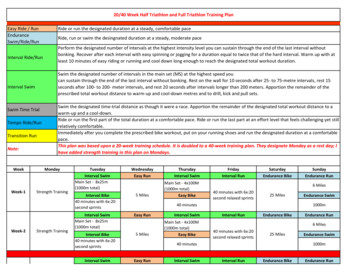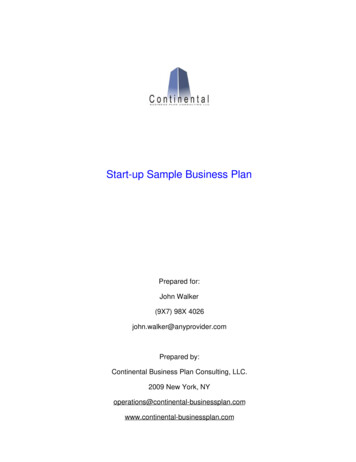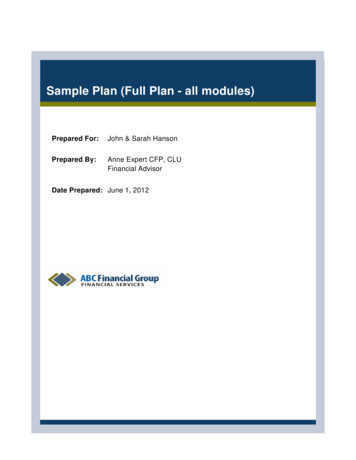
Transcription
Sample Plan (Full Plan - all modules)Prepared For:John & Sarah HansonPrepared By:Anne Expert CFP, CLUFinancial AdvisorDate Prepared: June 1, 2012
John & Sarah HansonTable of ContentsDisclaimerLetter of EngagementSummaryPersonal InformationGoalsCash FlowNet WorthAsset Allocation ProfileAsset AllocationRetirementLife InsuranceEstate Planning ChecklistEducationRecommendationsAnne Expert CFP, CLU, Financial AdvisorThe Financial Group
John & Sarah HansonDisclaimerFigures stated in the attached report are derived based on assumptions and information provided by you, theclient. These assumptions and information will change over time. Some of the information presented is based oncurrent tax rules and legislation which are subject to change. Hence, it is imperative that you review yourfinancial plan regularly to ensure it is up-to-date and addresses your current needs. It is also important to look ata few different scenarios to get an idea of the impact of various assumptions on your planning objectives.Information provided in the attached report is general in nature and should NOT be construed as providing legal,accounting and/or tax advice. Should you have any specific questions and/or issues in these areas, pleaseconsult your legal, tax and/or accounting advisor.Anne Expert CFP, CLU, Financial AdvisorThe Financial Group
Letter of EngagementThis document is meant to give you, the client, a better understanding of what you may expect from thefinancial planning process, and what our respective obligations are within that process. In general terms, thefinancial planning process consists of the following six steps: 1. Define the terms of our relationship 2. Discussyour financial goals and obtain your essential financial data 3. Evaluate your situation based on the informationyou ve provided 4. Develop and present a written financial plan for you to consider 5. Implement some or all ofthe strategies outlined in the plan 6. Monitor and revise the plan as necessary Much of what follows in thisdocument deals with the first point, but you will find information that relates to the other five steps as well.I provide comprehensive financial planning services through NAME OF COMPANY, a company that has beenestablished since XXXX for that purpose. We do not charge a fee for our financial planning analysis. What we doask of you, is that if you decide to implement our recommendations, you allow us to place your investments andinsurance. We are paid a commission or a finders fee by the various financial institutions that we place yourinvestments with.Since I offer both mutual funds and insurance products, I work in an agent-principal relationship with differentcompanies. All mutual funds are offered through my mutual fund dealer [insert NAME OF DEALER] and I placemy insurance business with [insert NAMES OF INSURANCE COMPANIES AND MGAs]. If, subsequent to ourinitial engagement, there are any changes to my business affiliations or agency relationships that may have anaffect on our relationship, I will inform you.I am required to declare any interest that may prevent me from offering disinterested advice. I am unaware of anycurrent conflicts of interest and, should any conflicts appear in the future, you may rest assured that I will bringthem to your attention immediately.I am bound by professional secrecy and may not disclose any of your confidential information without yourwritten consent unless required to do so by law. I will not use any client s information for personal benefit,regardless of whether or not it actually causes the client harm.I am able to offer general advice about life insurance and insurance-related products such as segregated funds,annuities, disability insurance, critical illness insurance and long-term care insurance. Should we, however,decide that you require a particular insurance product, I will refer you to our in-house insurance specialist [insertNAME]. With a Level II insurance licence and more than [X] years of experience in the insurance industry,he/she is better qualified to provide advice appropriate to your situation.It has been agreed by all parties that [NAME of CLIENT] and [NAME of SPOUSE] must be present at allmeetings and that decisions can only be made subject to their unanimous approval. It is agreed by both theadvisor and the client that telephone orders will not be accepted, and that the client must provide his or hersignature as authorization for every transaction.Before making any recommendation, I must first have a complete picture of your current financial situation. Theinformation I need deals with, but isn t necessarily limited to, your: assets; liabilities; cash flow; anticipatedlump sum income or expense amounts; tax position/returns; will and power of attorney; iInsurance coverage (lifeand general); group benefits; and pension plans. If I am unable to obtain the information I require, you shouldunderstand that it could prevent me from giving you appropriate advice; if this is the case, I may be required toeither revise or terminate our engagement.
Letter of EngagementWhen considering the various financial strategies available in your particular situation, I may be required tomake one or more assumptions. These assumptions may include, but are not limited to, your anticipatedretirement age, life expectancy, retirement income requirements, government benefits, time horizons, specialneeds, rates of return and inflation and income tax rates. Any assumptions I make will be both reasonable andrealistic, and they will be disclosed to you in writing in the financial plan.Having reviewed your financial situation, I will prepare a written financial plan for you to review. When discussingthis report with you, I will do so in such a way so that you are able to understand: The advantages anddisadvantages of the various alternatives; The costs of the various alternatives; The risks involved in the variousalternatives; The time sensitivity of recommendations; The consequences of no action being taken; and Theimpact of a change in the assumptions on the projected results. The client is obliged to inform the advisor if heor she does not understand any of the above points.It is agreed that the advisor will conduct a review with the client in person every twelve months.The advisor will keep the client informed of important changes through his/her quarterly newsletter. In the eventof changes that may affect the client s personal circumstances (e.g., a change to the Income Tax Actannounced in a federal budget), the advisor will contact the client by telephone or e-mail. Should the client sfinancial circumstances change (e.g., as a result of marriage, birth of a child, inheritance, etc.), he/she isresponsible for contacting the advisor as soon as possible.Date:John HansonSarah HansonAnne Expert CFP, CLU, Financial AdvisorThe Financial Group
John & Sarah HansonPlan SummaryNet WorthCash FlowTotal AssetsLiabilities 470,000 130,000Family Income (after taxes)Total Expenses 75,831 49,400Your Net Worth 340,000Your Net Cash Flow 26,431Asset Allocation ent PlanYou do not have enough funds to sustain you through retirement.Additional assets required to fund your retirement: 169,429Annual investment required to make up the above asset shortage:Life Insurance Needs 4,983JohnSarah 1,128,882 587,500 1,317,911 497,500 541,382 820,411Disability Insurance NeedsJohn DisabledSarah DisabledTotal annual income sourcesLess annual expenses 89,000 79,503 71,000 79,503 9,497 -8,503JohnYesYesYesSarahYesYesYesTotal capital requiredLess current capitalLife insurance needAnnual income surplus/shortageEstate PlanningDo you have:A signed will?A signed power of attorney for financial affairs?A signed power of attorney for personal care?Education PlanningAnne Expert CFP, CLU, Financial AdvisorMonthly InvestmentAmount to be FundedThe Financial Group
John & Sarah HansonPersonal InformationpersonalFirst NameLast NameBirthdateAgeMarital StatusSIN rahHanson16/05/196943MarriedDofasco Inc.EngineerAcme.comVP MarketingaddressStreetCityProvincePostal CodeCountryknow your client76 Henison BlvdWinnipegManitobaR9A 3L5CanadaInvestment KnowledgeModerateRisk ToleranceModerateContact InformationHome PhoneYour Work PhoneSpouse's Work PhoneEmail AddressEmail t NameHannahJacksonLast JohnSarahDo you have a will ?Date of last updateLocation of willYes01/01/2008Safety deposit boxYes01/01/2008Safety deposit boxAge51SIN #NotesAnne Expert CFP, CLU, Financial AdvisorThe Financial Group
John & Sarah HansonPersonal Informationlife insurancecompanyinsuredTerm Life PolicyTerm Life ty insurancecompanyinsuredLong term disabilityLong term disabilityDofasco Inc.London LifeClientClientother al advisorLawyerAccountantInsurance agentTerry BradshawKyle McLachlanAdam KennedySandra 5-5778coverage amount 500,000 400,000monthly coverage 1,000 750coverage amountnotesAnne Expert CFP, CLU, Financial AdvisorThe Financial Group
John & Sarah HansonFinancial Planning ProcessThe Six Step Process ofPersonal Financial PlanningPersonal financial planning focuses on theindividual. In order to best serve an individual'sneeds, the professional financial planningpractitioner employs The Total FinancialPlanning Process comprising these sixdistinct steps:Step 1Clarify Your Present SituationThe financial planner clarifies your presentsituation by collecting and assessing allrelevant financial data such as lists ofassets and liabilities, tax returns, recordsof securities transactions, insurancepolicies, will, pension plans, etc.Step 2Identify Goals and ObjectivesThe financial planner helps you identify both financial and personal goals and objectives as well as clarify yourfinancial and personal values and attitudes. These may include providing for children's education, supporting elderlyparents or relieving immediate financial pressures which would help maintain your current lifestyle and provide forretirement. These considerations are important in determining the best financial planning strategy for you.Step 3Identify Financial ProblemsThe financial planner identifies financial problems that create barriers to achieving financial independence. Problemareas can include too little or too much insurance coverage, or a high tax burden. Your cash flow may beinadequate, or the current investments may not be winning the battle with changing economic times. Thesepossible problem areas must be identified before solutions can be found.Step 4RecommendationsThe financial planner provides written recommendations and alternative solutions. The length of therecommendations will vary with the complexity of your situation, but they should always be structured to meet theyour needs without undue emphasis on purchasing certain investment products.Step 5Implement StrategiesA financial plan is only helpful if the recommendations are put into action. Implementing the right strategy will helpyou reach the desired goals and objectives. The financial planner should assist you in either actually executing therecommendations, or in co-ordinating their execution with other knowledgeable professionals.Step 6Monitor and ReviewThe financial planner provides periodic review and revision of your financial plan to assure that the goals areachieved. Your financial situation should be re-assessed at least once a year to account for changes in your lifeand current economic conditions.Anne Expert CFP, CLU, Financial AdvisorThe Financial Group
John & Sarah HansonYour Goals and ObjectivesMaintain your standard of living during retirement.Pay less tax.Maintain your family's standard of living in the event of your death or disability.Become financially independent.Preserve your estate for your heirs.Provide for your children's education.Pay off your mortage and other debts.Stay ahead of inflation.Earn a higher rate of return on your investments.Buy a home or recreational property.Learn to invest and manage money wisely.Start your own business.Anne Expert CFP, CLU, Financial AdvisorThe Financial Group
John & Sarah HansonCash Flow StatementWhy Prepare a Cash Flow Statement?Controlling your financial affairs requires a budget or cash flowstatement. Budgeting and tracking your expenses gives youa strong sense of where your money goes and can help youreach your financial goals, whether they are saving for a downpayment on a house, starting a college or university fund foryour children, buying a new car, paying off the credit cardsor planning for retirement. A cash flow statement providesyou with the following benefits:Know where you standA cash flow statement allows you to knowexactly how much money you have. Thestatement shows you how your funds areallocated, how they are working for you, whatyour plans are for them, and how far alongyou are toward reaching your goals.The statement will also:- Indicate your ability to save and invest- Let you analyze your standard of living- Indicate if you're living within or beyondyour means- Highlight any problem areasControlA budget is the key to enabling you to take chargeof your finances. With a budget, you have the toolsto decide exactly what is going to happen to yourhard-earned money, and when.CommunicationA budget is a communication tool with other family membersto discuss the priorities for where your money should be spent.Identify opportunitiesKnowing the exact state of your personal monetary affairs, and being in control of them, allows you totake advantage of opportunities that you might otherwise miss.Ex
financial planning process, and what our respective obligations are within that process. In general terms, the financial planning process consists of the following six steps: 1. Define the terms of our relationship 2. Discuss your financial goals and obtain your essential financial data 3. Evaluate your situation based on the informationFile Size: 2MBPage Count: 46




